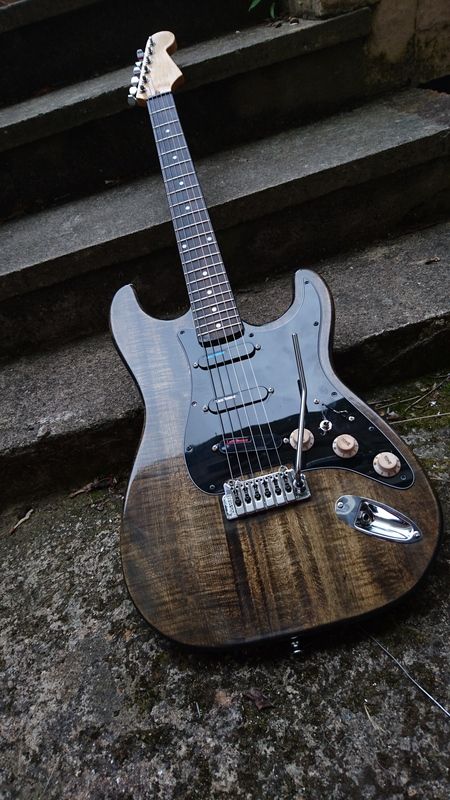Yes, the Evertune bridge requires substantial wood removal. However, in my opinion, it's well worth doing. I cannot speak highly enough about the Evertune. It's life changing.
This short scale project has now been completed, and the real fun of playing it a lot now begins !

Above is a picture of the completed guitar.
Walnut body from Warmoth.
Custom short scale neck, mahogany core wood, ebony fingerboard. Created by Allied Lutherie in Vermont, whom I highly recommend.
Evertune routing and all assembly work and finish, by Justin Kennedy in Cincinnati, whom I also very highly recommend.
Fender branded safety post style tuners, which are actually made by Ping Works, and which are utter and total rubbish, and thus I highly do NOT recommend.
These have since been replaced by locking tuners by HipShot, which so far seem to be great.
I originally wanted safety post tuners, since I love their clean look, and most importantly I want an easy way to remove and reinstall the same string set, for example when changing pickguards.
I am hoping that doing this with the HipShot tuners will be easy, but I have not tried it yet.
Set of Ultrasonic pickups, a throwback to the 1980s. Great sounding pickups, very flat, low output, but not made any more.
Custom pickup wiring scheme devised by yours truly. Master volume, master tone, standard 5 way Strat switch, rotary 6PDT switch that changes all three pickups to have their dual windings in series or parallel.
Evertune bridge of course.
The Evertune is not a whammy. They have been working on a whammy version for years, and continue to promise one some day.
I love the Evertune enough, even without being a whammy, that I intend to use nothing else.
However, my need to warble and shimmy remains undeniable, and led me to the following hackoid invention-ette.

I inserted some small allen wrenches into the ferules of the first three strings (the thicker strings would not allow this).
(Note that the strings are all loose in this photo.)
I used some pieces of a rubber band from a celery bunch to keep these allen wrenches from crossing.
This allows a small amount of pitch warp, in a similar way to grabbing a Strat trem plate (sans bar) and rocking it. No dive bombs, but better than nothing.
This can at least pacify me a bit until Evertune changes the world with a trem that stays in tune for the life of the strings.
As an example of how cool the Evertune is, consider this scenario.
Guitar is strung up and tuned to pitch.
I decide to change pickguards.
So I loosen and remove the strings from the tuners, but leave the strings in the bridge.
I swap the pickguard as desired.
I replace the same strings back onto the tuners.
At this point, the magic happens. I do NOT need to retune anything.
I simply start tightening the tuners.
As the string pitch rises, the Evertune mechanism begins to kick in.
The string pitch rises until it's back in perfect tune again, at which point the pitch stops increasing and I thus simply stop tightening the tuners.
No need to check tuning with a tuner. It's perfectly in tune.
My current adventure is of course playing this guitar a lot and getting used to it.
It's fantastic, and it's a ton of fun to play.
Once I feel completely comfortable with all of the new ideas embodied in this guitar, ensuring that everything is good and groovy, my next adventure will be to make another one.
This next one will use different woods, and likely humbuckers instead of Strat-sized pickups.
For any like minded short scale folks, this short neck has been a complete success.
Luthier Justin Kennedy also confirmed that the body of this guitar could have a standard neck placed on it, and with minor adjustment to ensure proper intonation, it would be just fine.
That was the whole purpose of doing this - to create a short scale neck that could bolt onto a standard Strat body, without requiring any hackery to bridge placement, neck pocket, neck heel, etc.
Surely constructing a custom neck is not a cheap fix, but it achieved a completely excellent result, exactly what I was trying to do.
More news as it comes.
Cheers
Bob











